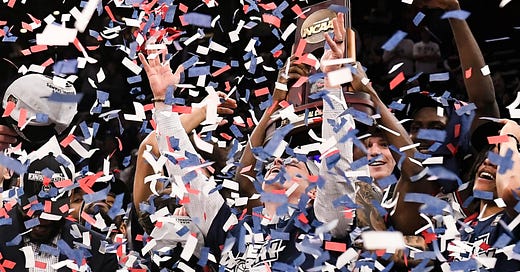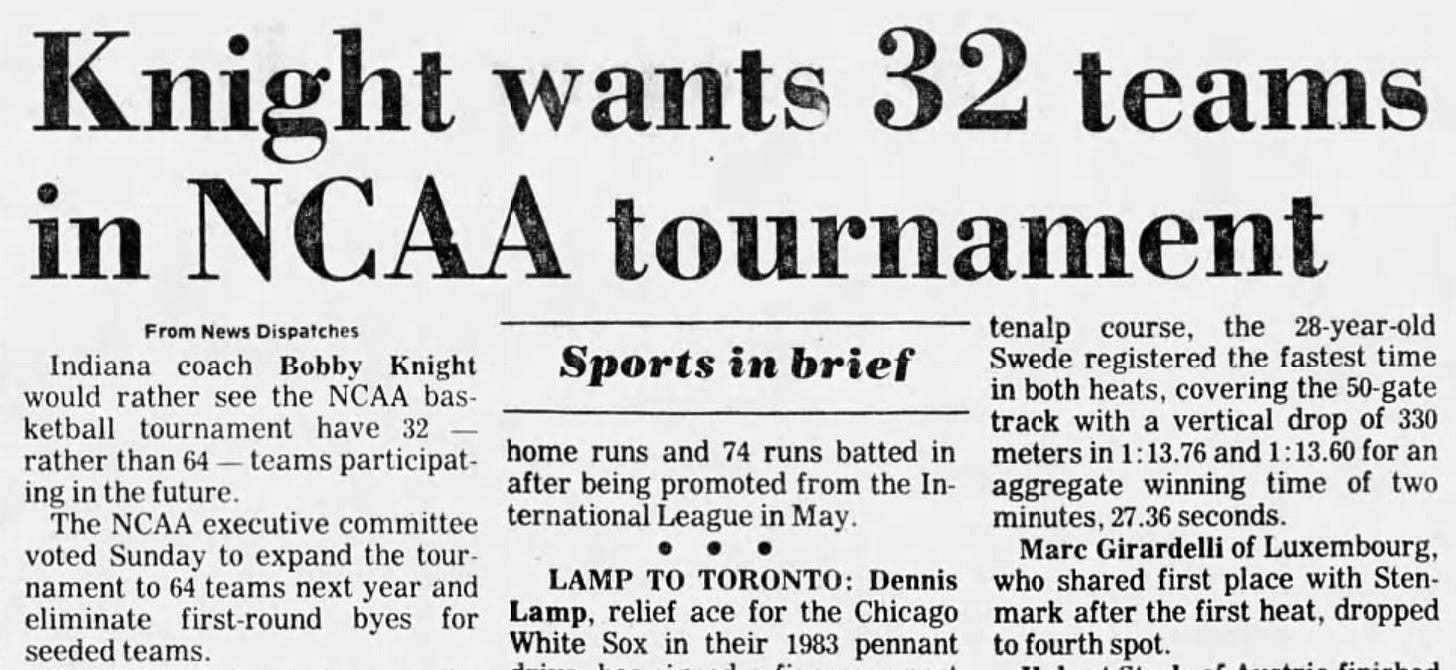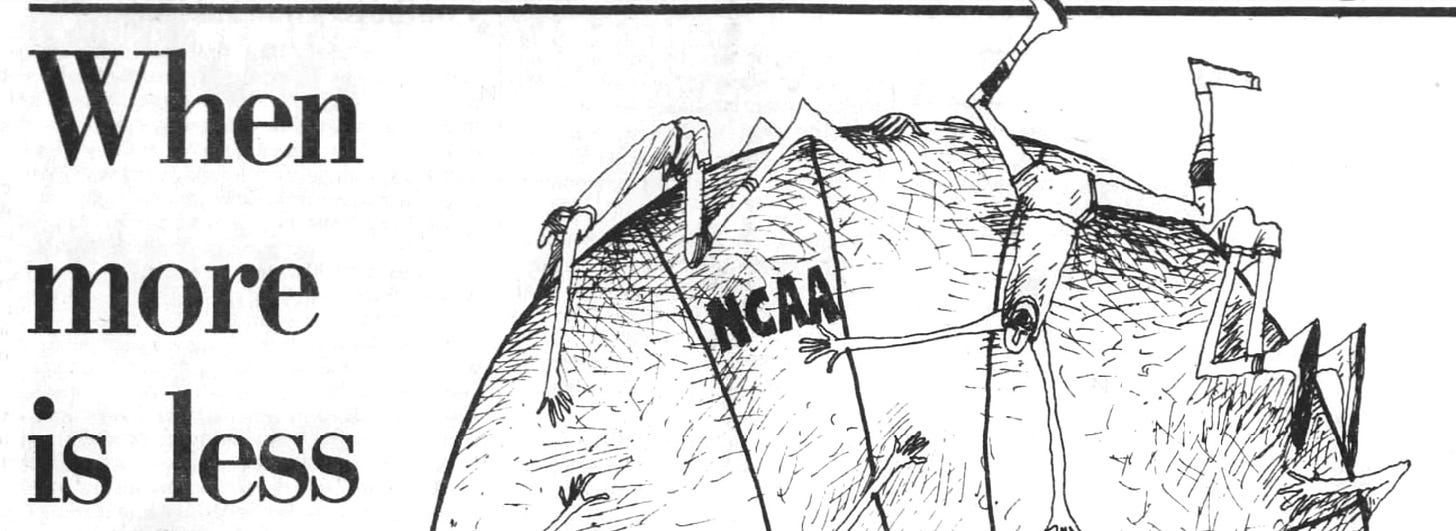I’m on the record as suspecting that a judicious expansion of the men’s Division I NCAA tournament bracket could be a good thing. Mine, however, is decidedly a minority opinion and I have great respect for the legions of commentators who beg to differ. In that spirit of respect here’s what is and is not working for me in the anti-expansion pieces I’ve seen.
What is working for me are straight howls of protest over expansion talk, cries that express not only adoration of the status quo but also peace of mind regarding the risks of maintaining it. Such screeds are rooted in a love of March that I understand completely and share most deeply.
I’m not on side with running these particular risks, it’s true, but our disagreement centers on what may happen in the future. Goodness knows tens of thousands of my words strewn across multiple extant sites as well as the Wayback Machine document how very wrong I can be about what might occur tomorrow or the next day. Quite possibly I’m mistaken this time as well. Howl away.
What’s working less well for me are pieces that spray a fine mist of evaluative disdain on the tiny number of bubble teams that would get in only under expansion. Please, no more. This is research done the way a drunk uses a lamppost, more for support than illumination. Of course the profiles for these teams look underwhelming. March hasn’t happened yet.
If you’re handing out a priori dismissiveness, at least include the equally bubbly teams that do get bids under the regime of 68. Why sweat dire expansion hypotheticals when we have actual horror stories like Virginia 2024? Does that mean we should we contract the field?
At the other extreme consider UCLA four years ago. The Bruins lost four straight going into the 2021 First Four. Then Mick Cronin’s group reached the Final Four and took 30-0 Gonzaga to overtime in one of the best national semifinals I’ve ever seen. Happily, UCLA’s underwhelming team sheet was just barely good enough to secure a bid. Possibly March will continue to do just as it pleases even if we throw 20 or 21 percent of D-I at the month instead of the current 19.
What could work for me in support of the status quo would be something that addresses the following three questions.
Why is maintaining the status quo correct now when it wasn’t in 1984?
The 64-to-68-team era has been a spectacular success. A golden age, even. It’s been 41 years since the NCAA announced it would expand the field to 64 teams.
And in 1984 that announcement was roundly criticized in the press….
“Have the gentlemen who run this spectacle lost their minds? Is the NCAA adding teams simply to give television more games?”
“Next season, the NCAA tournament will expand to 64 teams. That’s way too many.”
“I don’t think there are 64 outstanding teams for the championship level.”
“If the NCAA Executive Committee isn’t careful, it may be messing with something it shouldn’t.”
“Sixty-four is mind-boggling.”
“The NCAA basketball tournament will be expanded next year to 64 teams from this year’s 53, bringing the tournament to twice the size it should be….”1
Journalists criticizing expansion had good company in Dave Gavitt. Final Four coach, founder of the Big East, men’s basketball committee chair, US Olympic team head coach, and hiring target of multiple NBA franchises, Gavitt forgot more about basketball than you or I will ever know. And he was vocally wary of a 64-team bracket: “It scares the hell out of me.”
Give Gavitt credit, he walked that walk. In December 1983 when the men’s basketball committee voted 8-to-1 in favor of 64 teams, Gavitt’s was the lone vote in opposition.
In 1984 the most common charges laid at expansion’s door were: 1) the tournament is excellent the way it is; 2) the people leading the expansion push are just after money; 3) expansion will reward mediocrity. In what respects will opposition to expansion prove more correct in 2025 than it was four decades ago?
Where do mid-majors stand?
Pro-status-quo advocacy can on occasion veer toward the polemical equivalent of mansplaining. Such pieces are prone to stating baldly, preemptively, and unselfconsciously what is best for mid-majors.
It would be helpful to know what the men and women who lead and coach and represent mid-majors have to say regarding this matter of foundational importance to them. Certainly Atlantic 10 commissioner and recent men’s basketball committee member Bernadette McGlade, for one, has been forthright in championing expansion. She has more at stake than do we who write and talk about such things. Is she wrong?
The performance hierarchy of men’s basketball in a D-I population that’s 78 percent mid-major is lopsided toward major-conference programs in the top tiers. As a result each expansion of the field does improve the odds however slightly that a mid-major will earn an at-large bid. In the abstract such an observation is factual to the point of being redundant. The good news is that in the real world selection outcomes since 2011 have been similar for both major-conference and mid-major at-large candidates when controlling for Selection Sunday KenPom ranks.
Naturally this good news is past-tense and the future’s a blank slate. Major conferences have not only lobbied for an expanded field but in their more brutish moments have been known to push for more “representation on NCAA championship selection committees.”
This potential for malign influence is one more excellent reason why we shouldn’t have selection committees in basketball! Still another excellent reason is that it’s 2025.
Mid-majors can compete for at-large bids if the playing field is level. We should use an NCAA-administered win proxy to build the bracket. Until that happy day arrives let us hope the archaic 1960s-era committee will elude total major-conference capture even as it chews up hundreds of member-hours to duplicate 95 to 99 percent of what a win proxy already said.
What level of existential risk is worth freezing the field at 68?
If we’re tasked with summing up the past 50 years in D-I revenue sports with one or two broad trends that can double as reasonably sound predictive rules, my nominees might be:
The interests of elite football will prevail.
Whether by free will or court order the NCAA will do the right thing eventually but with glacial slowness.
Broad trend No. 1 isn’t offered cynically or meant to portray elite football’s stewards as particularly sinister. Those stewards are pursuing their objectives like the rest of us, they just happen to do so from a uniquely privileged and influential position that carries high potential for impacts downstream.
If you’re like me and you suspect a modest upsizing of the men’s basketball bracket could be good purely on the merits, you view elite football’s 2020s campaign for tournament expansion as a Naismith-sent opportunity. At one stroke we can secure a few precious years of detente with Big Football, enhance opportunities for mid-majors, and transform Tuesday and Wednesday from sleepy to superb.
Conversely if you think expansion would be harmful the present situation will — or should — appear far more fraught. Elite football of course declared its independence from the NCAA in the 1980s. D-I in 2025 comprises an increasingly fractious alliance. For now the most visible tie still binding the alliance together is its championship basketball event.
The crowning glory of the NCAA tournament is that it’s an open championship. For the moment the autonomy conferences are still routing their basketball aspirations through the NCAA’s postseason event. Those conferences say they want an expanded bracket. If they’re refused it will mark a win for preservation only if a single recognized national championship event open to all does survive five years down that road.
Already the four power football conferences are drafting a proposal to run their own basketball postseason:
The proposal, a collaboration of the four power leagues, would grant the SEC, Big Ten, Big 12 and ACC rights to manage postseason championships, such as the men’s and women’s basketball tournaments, assuming control over events that have long been operated by the national association.
It’s just a working document, the conference commissioners assure us. The leagues are still committed to the NCAA tournament, they hasten to add. Meanwhile the rest of us are flagging the idea of going from two games to four on Tuesday as the step that could bring forth the apocalypse. I’m not at all certain we understand the value of what’s been handed to us.
Al Dunning of the Memphis Commercial Appeal was one exception to the anti-expansion rule in 1984. Dunning wrote that the NCAA “finally has hit upon a sensible number of invitations to issue for its annual slam-dunk festival….It has taken the better part of the 20th century for college basketball to design a tournament bracket that is both large enough and reasonably fair to all its participants.”







Using your archival research experience again in the college basketball world is a fun time! It's a great idea to reflect on how the expansion to 64 was viewed and debated as it seems very similar. Anchoring on, 'but it's so good now' is very strong.
I think related to what you are saying here is anti-expansionist worry that whatever change *is* made will block more preferred alternatives. In some people's minds, it's not a choice between 1) expand to 80 teams (with current procedures) and 2) no change, but between 1) expand to 80 teams (with current procedures) and B) expand to 80 teams with a process that more strongly supports mid-majors (or makes all play-ins among at-large qualifiers or whatever someone wants). If we went from 1 -> 2, B would probably be off the board, so let's just anchor at the status-quo and fantasize about ending up at B.
And lastly, I should have thrown this out when Seth Davis did his twitter version of the "change-my-mind" meme, but is the fear of being 'too big to consume' real? I can pause my other life for
4 days starting noon on Thursday, but if really diving in also costs 20+ hours over Tues/Weds, will some skip it and have the monoculture fade? It's like the choice of binging an 8-episode show over one weekend instead of watching a 20-episode acclaimed show that takes more commitment.